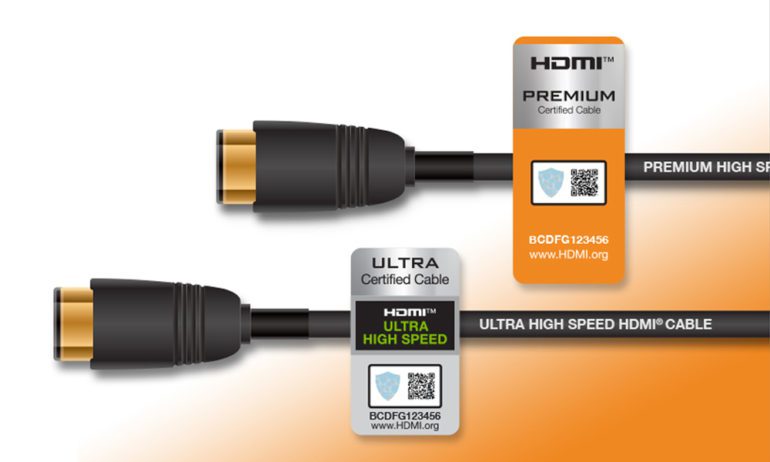By now, most of us are familiar with what an HDMI cable is. This cord connects your TV or monitor to all your soundbars, DVD players, game consoles, laptops, and more. However, not all HDMI cords are created equal. While HDMI 2.0 has been used for years, it has recently been updated with HDMI 2.1. Here’s everything you need to know about the difference between HDMI 2.0 vs HDMI 2.1 and which one you should buy for your home theater or gaming PC.
What Is HDMI?
HDMI stands for High-Definition Multimedia Interface. It is a connection standard for transferring media from a source (like a DVD player) to a display (like a TV). The technology improves on older standards because it can transmit high-definition audio and video with a single cable.
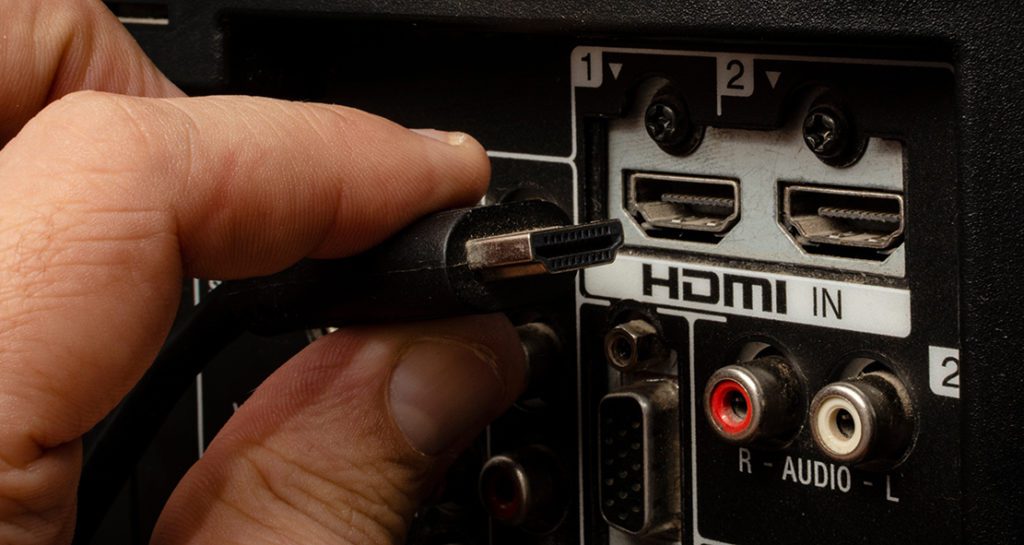
HDMI was first released in 2002, and now there are more than 8 billion devices that use the technology, according to the HDMI Forum. This is the organization in charge of improving HDMI technology and developing new HDMI specifications.
The newest HDMI specification is HDMI 2.1, which was released in 2017. However, HDMI 2.0, which was released in 2013, is still the most popular specification.
What Is the Difference Between HDMI 2.0 and HDMI 2.1?
The main difference between HDMI 2.0 and HDMI 2.1 is that the newer specification has a higher bandwidth capacity. That means HDMI 2.1 can transfer more data at a time, which allows it to support higher resolutions, faster refresh rates, and other features.
You can think of bandwidth like a water pipe; the wider it is, the more water can flow through at a time. In the same way, a higher bandwidth capacity allows for more data to be transferred at once. While HDMI 2.0 has a bandwidth capacity of 18 Gbps (gigabits per second), HDMI 2.1 more than doubles the capacity, supporting up to 48 Gbps.
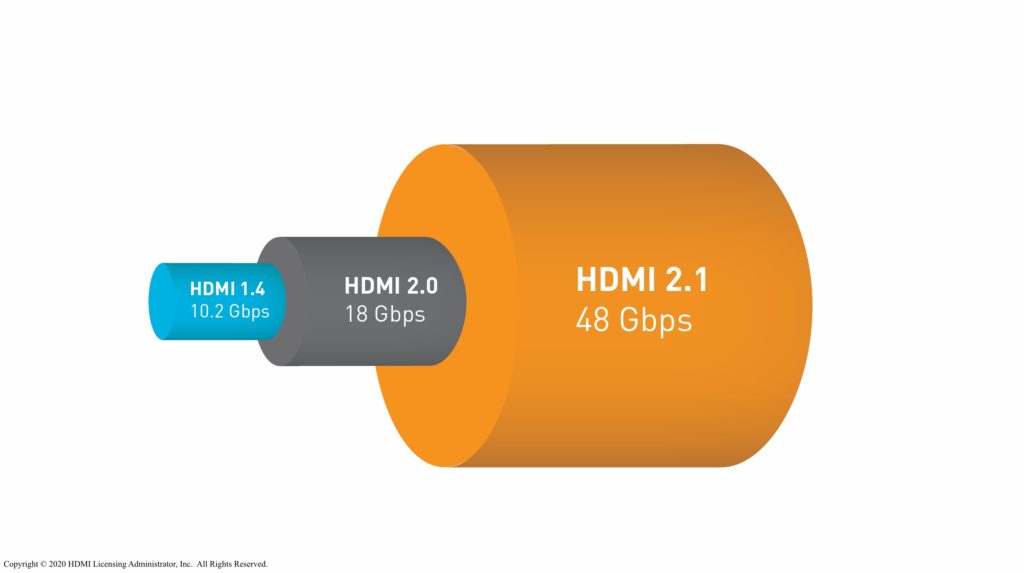
With its increased bandwidth capacity, newer HDMI specifications won’t have to compress data as much, which can lead to better audio and video quality. However, you might not be able to take advantage of the newer specifications unless you have a newer TV or monitor.
HDMI 2.0 vs 2.1: Video Resolution
HDMI 2.1 supports video resolutions up to 10K or 8K uncompressed, while HDMI 2.0 can only support resolutions up to 4K. That means you will be able to see more detail, and images will look sharper when you use an HDMI 2.1 cable, but only if the TV, video, and media player are all compatible with higher resolutions.

However, an HDMI 2.0 cable only lets you watch 4K content at 60 frames per second, which isn’t fast enough for some content. So, if you have a 4K TV, you still might want to opt for an HDMI 2.1 cable.
Read More: What is the difference between 4K and 1080p?
HDMI 2.0 vs 2.1: Refresh Rate
HDMI 2.1 supports refresh rates up to 8K at 60 Hz (Hertz) or 4K at 120 Hz, while HDMI 2.0 only supports 4K at 60 Hz. Refresh rate refers to how many times the display refreshes the image per second. A high refresh rate generally leads to smoother motion, especially when gaming.
(Image Source: Nvidia)
Ideally, you want your refresh rate to be equal to or higher than your video’s frame rate. Otherwise, you might experience motion blur and screen tearing. HDMI 2.0 supports 1080p at 240 Hz or 1440p at 144 Hz, which makes it fast enough for most movies, TV shows, and games.
And while you can get away with using an HDMI 2.0 cable with a 4K display, some content won’t look as smooth because it caps out at 60 Hz. So, you should buy an HDMI 2.1 cable if you have an 8K or 4K display or if you want the best performance out of a gaming computer.
Read More: What is a good refresh rate for a TV?
HDMI 2.0 vs 2.1: HDR
HDMI 2.1 and HDMI 2.0 both support a feature called HDR (high dynamic range), which increases the range of light and color that a video can display. However, only HDMI 2.1 formally supports dynamic HDR, which increases the picture quality even more.
With static HDR, you can see more detail in the shadows and highlights of an image, but there is only one set of information to define the light levels of an entire video. So, if one scene in a movie is too bright, it can make the rest of the movie look a little dark.
With dynamic HDR, the brightness range of a video can be analyzed frame-by-frame, which leads to more life-like images. However, you can only use this feature if your TV or monitor supports dynamic HDR, such as HDR10+ or Dolby Vision.
Read more: What is HDR, and what does it do?

While HDMI 2.1 formally has dynamic HDR built-in, this feature can also be used with some HDMI 2.0 cables. However, if you want to be sure that you are getting the best picture quality, you should opt for an HDMI 2.1 cable.
HDMI 2.0 vs 2.1: Audio
HDMI 2.1 and HDMI 2.0 both support a feature called ARC (audio return channel), which allows a single cable to send and receive audio signals from your TV to a soundbar or AV receiver. However, only HDMI 2.1 supports eARC (enhanced audio return channel).
With ARC, you can listen to surround sound audio, but it will be compressed. On the other hand, eARC has a higher bandwidth capacity, so it supports uncompressed surround sound, including audio formats like DTS Master, DTS:X, Dolby TrueHD, and Dolby Atmos 3D surround sound.
Read More: What is Dolby Atmos, and is it worth it?
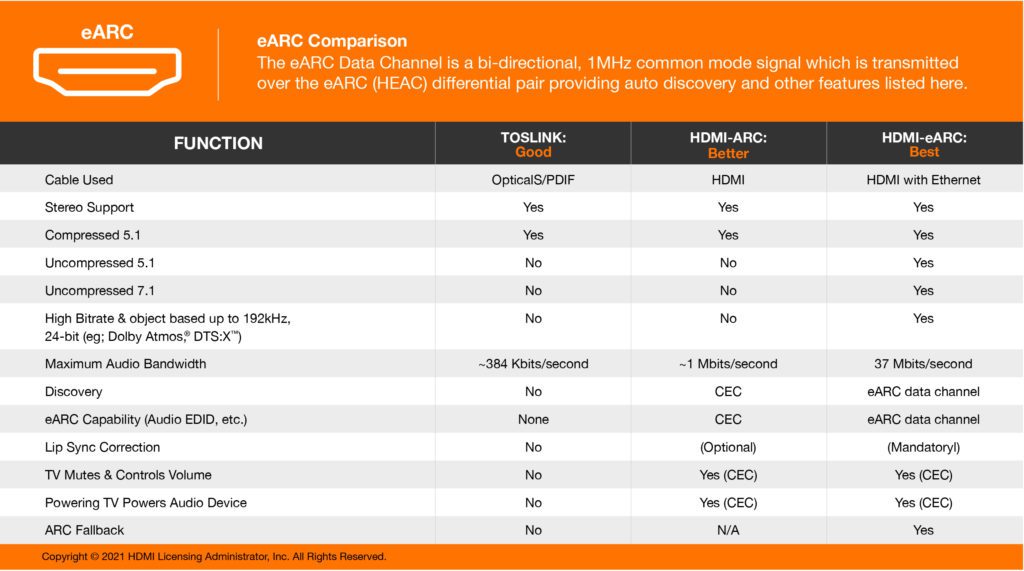
In order to take advantage of eARC with HDMI 2.1, you will need a compatible TV or monitor paired with a compatible soundbar or AV receiver.
Read more: HDMI ARC vs HDMI eARC: What’s the difference?
HDMI 2.0 vs 2.1: Gaming
One of the biggest differences between HDMI 2.0 and HDMI 2.1 is noticeable when gaming. Only HDMI 2.1 has advanced features like VRR (variable refresh rate), which reduces screen tearing, and ALLM (auto low latency mode), which reduces lag.
HDMI 2.1 comes with VRR built-in, which allows the refresh rate of your display to match the frame rate of your game in real-time. Without this feature, your display will sometimes try to show information from two frames at once. This causes screen tearing, which is usually characterized by a horizontal break in the image.
(Image Source: Nvidia)
You can also get VRR with a display that supports FreeSync or G-Sync technology. While you can use an HDMI 2.0 cable with a FreeSync display, a G-Sync display will require an HDMI 2.1 cable or a DisplayPort 1.2a cable or higher.
Read More: What’s the difference between HDMI and DisplayPort?
In addition, HDMI 2.1 also has ALLM (auto low latency mode), which automatically enables the ideal latency settings on your display (usually the “game mode”). Then, when you switch back to watching a movie, the setting will be turned off automatically to give you the best picture quality.
A lower latency will also make a game feel more responsive by reducing the time it takes for your inputs (from a mouse or a controller) to reach your display. And, with its higher bandwidth capacity, HDMI 2.1 will also process images faster. This can give you an advantage over other players that take longer to render images.
(Image Source: Nvidia)
HDMI 2.1 is found on the Xbox Series X and PlayStation 5. And while you don’t need HDMI 2.1 to play games on either next-gen console, you won’t get all the best features with an HDMI 2.0 cable.
Read More: Xbox Series X vs PS5: What’s the difference?
Is HDMI 2.1 Worth It?
HDMI 2.1 is only worth it if you have a 4K TV or if you connect your display to a soundbar or AV receiver that supports eARC. Also, if you’re a gamer, HDMI 2.1 can offer lots of features that are worth it even if you have don’t have a 4K display.
And, since HDMI 2.1 is backward compatible, a cable with the latest specification is guaranteed to work with any device. On the other hand, HDMI 2.0 might not work with some newer TVs and soundbars, so you might want to buy the newer specification to future-proof your home theater or gaming PC.
If you want to buy a new TV with HDMI 2.1 ports, check out our list of the best smart TVs.
How To Tell If Your HDMI Cable Is 2.1
All HDMI cables look the same. So, if you want to buy an HDMI 2.1 cable, you should look for a label that says, “Ultra-High-Speed HDMI,” along with the official logo for HDMI. On the other hand, an HDMI 2.0 cable will be labeled as “Premium High Speed.”
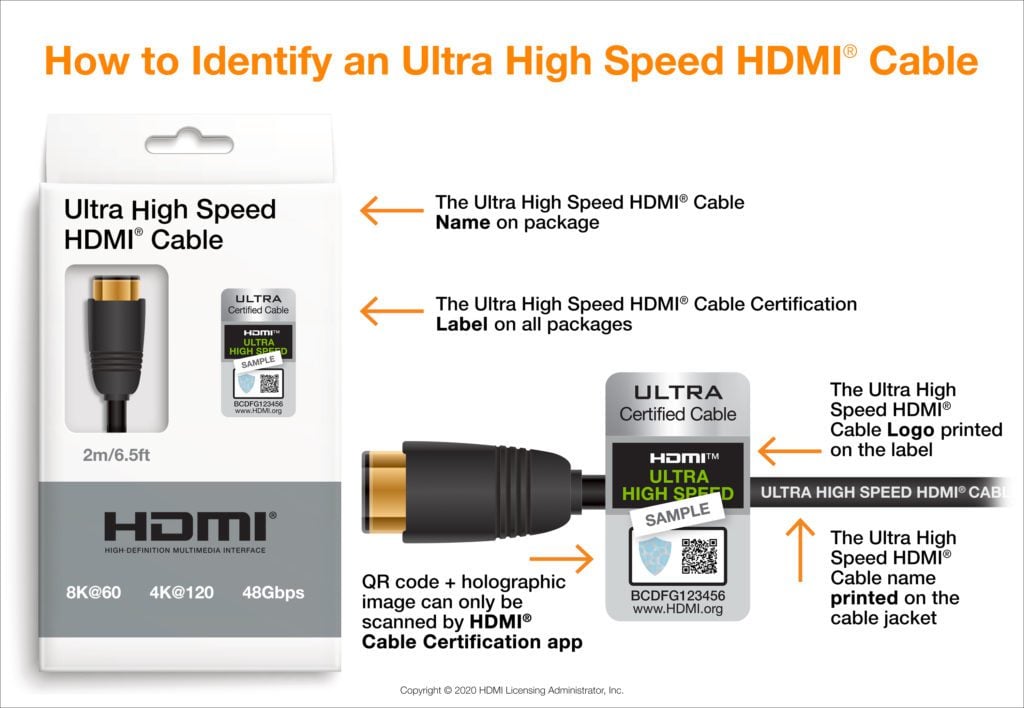
In addition to looking at the label, you can also scan the QR code on the box to ensure that it’s officially an HDMI 2.1 cable. To do this, you can download the official HDMI Cable Certification app from the Apple App Store or the Google Play Store.
